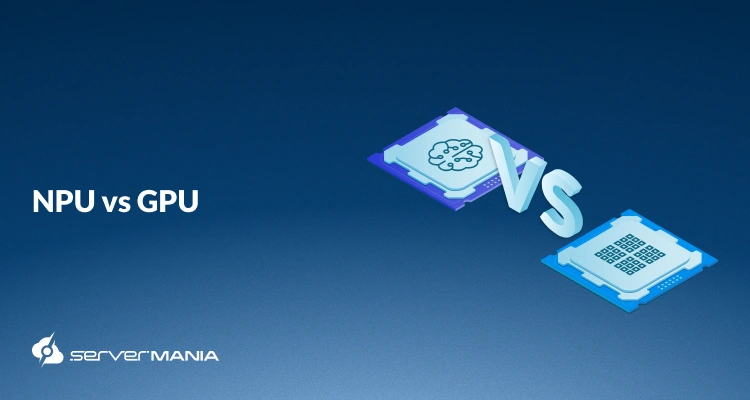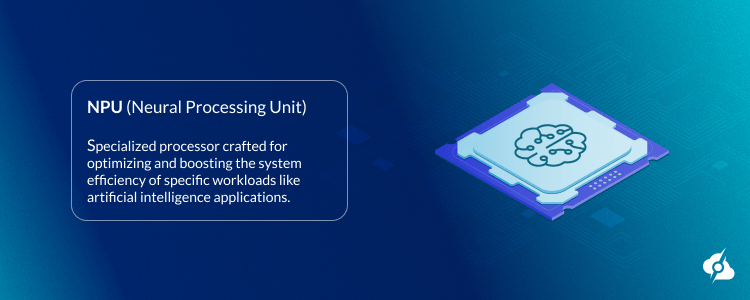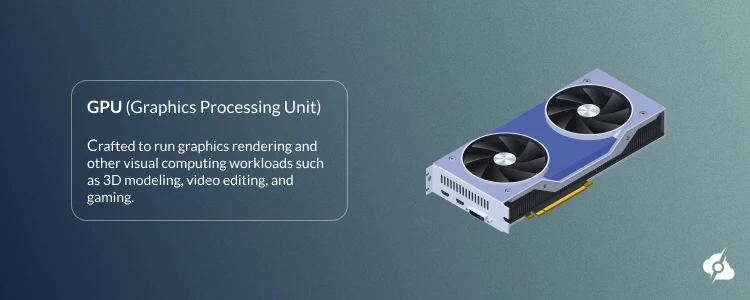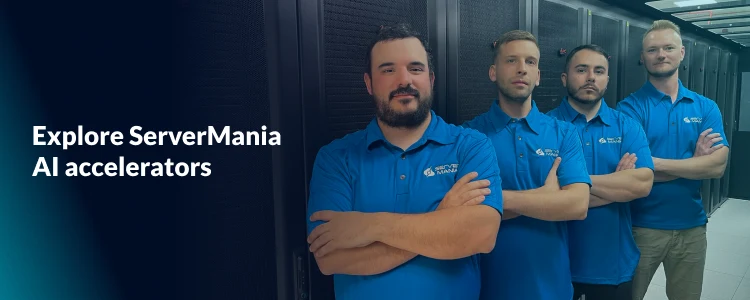NPU vs GPU: How To Choose The Right AI Acceleration Hardware

As artificial intelligence (AI) infrastructure and applications are scaling rapidly in today’s digitalization, the hardware behind them must evolve at the same pace. Neural Processing Units (NPUs) and the Graphics Processing Units (GPUs) are both great in machine learning tasks, but in very different ways.
While GPUs and NPUs are different processors designed for AI tasks, GPUs excel in parallel processing and rendering, whereas NPUs are made specifically for accelerating facial recognition and deep learning with minimal drawbacks.
ServerMania provides the infrastructure behind today’s most demanding AI applications. From GPU dedicated servers to full GPU server hosting and scalable cloud solutions, we help organizations deploy scalable, energy-efficient systems optimized for neural network models, large data volumes, and rapid access to GPU resources.
What is NPU? (Neural Processing Unit)
The Neural Processing Unit (NPU) is a specialized processor crafted for optimizing and boosting the system efficiency of specific workloads like artificial intelligence applications. Some of the areas NPUs are best at would be image recognition, facial recognition, and deep learning.

Contrasting the graphics processing units (GPUs), originally built for general computing that happen to be good at AI tasks, NPUs are engineered from the ground up for AI workloads.
The NPU architecture takes a completely different path towards computation. While central processing units (CPUs) are crafted to execute tasks in sequence, and GPUs work via parallelism, leading to high energy consumption, NPUs offer parallel operations with much lower power draw.
This is made possible by unique features like specialized compute units, high-speed on-chip memory, and a parallel architecture tuned for processing large data batches with minimal delay.
Key NPU Specifications:
- Specialized Compute Units: These specialized chips are dedicated hardware for multiplication and accumulation, essential for neural network training and inference.
- High-Speed Integrated Memory: The neural processing units (NPUs) enable quick access to the model data, minimizing bottlenecks related to memory access.
- Parallel Architecture: NPUs are great in executing hundreds, if not thousands, of operations at the same time, while being much faster than general-purpose computing chips.
- Energy Efficiency: NPUs offer the highest performance with the lowest power consumption, in localized and embedded AI processing data batches.
What is a GPU? (Graphics Processing Unit)
The Graphics Processing Unit (GPU) was initially crafted to run graphics rendering and other visual computing workloads such as 3D modeling, video editing, and gaming.

As time went on and AI/ML tasks started to rise, the parallel GPU architecture became a natural fit for data analysis and machine learning tasks. Their ability to process large data volumes in parallel is the main factor that keeps those chips in the lead for handling large language models.
If there is one standout feature that makes GPUs a valuable player in today’s AI infrastructure, this is their capability to perform thousands of floating-point calculations across multiple cores at the same time. This is excellent for batch processing and model training in cloud infrastructure and data centers.
Key GPU Specifications:
- Parallel Processing: The capability of handling many tasks at the same time makes GPUs ideal for workloads that involve training artificial intelligence.
- Tensor Cores: Graphics cards come with built-in capability to support critical applications in the world of AI, some of which include neural network acceleration and matrix multiplication.
- Versatile Performance: Since GPUs are not specifically designed for AI workloads, they are extra versatile because of their rendering capability.
- Resource Availability: GPUs have been on the market for years and come with vast community support, documentation, resources, and high availability.
See Also: What is the Best GPU Server for AI and Machine Learning?
NPU Vs GPU Key Differences:
If you’re up against the dilemma of whether to choose NPUs or GPUs for your next AI project, you need to understand what sets them apart. While both have their own strengths and weaknesses, each type of processor is designed to shine in different areas.
To acquire a better understanding of how both accelerators stack up against each other, let’s compare some of the most important factors:
| Neural Processing Unit (NPU) | Graphics Processing Unit (GPU) | |
|---|---|---|
| Purpose | Specialized processor designed specifically for neural network models and AI tasks | Originally designed for rendering, adapted for parallel computing in AI |
| Architecture | Highly parallel processing optimized for accumulation operations and multiplication | A massive number of cores optimized for parallel operations |
| Energy Efficiency | Extremely efficient, optimized for low power withdrawal, especially in mobile and edge devices | High power consumption; less energy efficient, but very powerful for large-scale AI training |
| Memory Access | Features high-speed integrated memory, allowing rapid access to model data | Relies on external VRAM with higher latency compared to NPU’s on-chip memory |
| Processing Focus | Best suited for inference and real-time AI applications with smaller batch sizes | Excels at training large AI models and handling big data volumes in batch |
| Use Cases | Mobile devices, edge computing, AI accelerators, and medical diagnostics | Data centers, cloud infrastructure, editing, and gaming |
| Integration | Often integrated into SoCs alongside CPUs and other components | Typically, discrete cards or integrated into servers and workstations |
| Latency | Lower latency due to specialized hardware and system resources | Higher latency, but compensates with raw parallel throughput |
| Software Ecosystem | Emerging support, optimized for AI frameworks focusing on inference | Mature ecosystem with broad compatibility across AI frameworks and operating systems |
| Flexibility | Designed for specific AI workloads; less flexible for other tasks | General-purpose, capable of graphics processing, AI, and other tasks |
| Manufacturers | Found in devices from various manufacturers, focusing on edge AI processors | Produced by major players like NVIDIA, AMD, widely available globally |
NPU Vs GPU Use Cases
If you’re wondering whether to choose a GPU or an NPU for your next AI project, you shouldn’t think about performance; rather, compatibility.
Yes, GPUs are vastly dominant for training AI models and working with vast data volumes, but NPUs are quickly gaining traction in areas that demand local AI and low latency. So, based on the project that you are working on, choosing between GPU and NPU is critical.
See Also: How to Set Up and Optimize GPU Servers for AI Integration
Let’s go over a few optimal use cases to help you determine:
NPU Optimal Use Cases
| Use Case | Description: | Common Examples |
|---|---|---|
| AI and Large Language Models | Handles real-time inference for language models, speech, and video analysis | Smartphone AI features, real-time video analytics, smart assistants |
| IoT and Mobile Devices | Efficient for compact, battery-powered devices with on-device AI | Wearables, IoT sensors, embedded AI |
| Data Centers | Improves AI workload efficiency with lower power draw | Energy-conscious AI clusters, AI-enhanced appliances |
| Autonomous Vehicles and Robotics | Powers low-latency vision and signal processing in autonomous systems | Self-driving perception, drones, and automated surgical tools |
| Edge Computing and Edge AI | Optimized for on-device AI near the user, reducing latency and data transfer | Battery-powered edge AI, smart home devices, AR/VR on mobile |
GPU Optimal Use Cases
| Use Case | Description: | Common Examples |
|---|---|---|
| AI, Machine Learning, Deep Learning | Ideal for high-throughput AI training and parallel computation | AI model development, multi-model serving, cloud AI services |
| Cloud Computing | Accelerates big data, analytics, and hosted inference workloads | Cloud AI, GPU server environments, Web3/Blockchain hosting |
| Visualization and Simulation | Powers complex visualizations in science and engineering | Medical imaging, CAD modeling, climate, and physics simulations |
| Blockchain | Enables compute-heavy proof-of-work operations | Crypto mining, blockchain validation, and distributed ledger tasks |
| Gaming and the Metaverse | Delivers high-end graphics rendering and immersive real-time experiences | VR gaming, ray tracing, AR worlds, MMOs |
| Video Processing and Content Creation | Speeds up rendering, encoding, and post-production workflows | YouTube editing, Hollywood VFX, TikTok apps, Final Cut Pro, Adobe Suite |
AI Applications: Benchmarks and Metrics
When comparing NPU vs GPU performance, it’s critical to look beyond what the market claims and take a look at some real-world benchmarks.
Inference Performance Comparison
A recent KAIST benchmark has shown that the NPU design can deliver up to 60 % faster inference than any modern GPU while using 44 % less power. This is really dramatic and reduces the cost of operation with any generative AI workloads.
Source: CLOUDTECH
An independent test by ARXIV of ultra-low-power NPUs signals very strong results in matrix‑vector workloads, with NPUs performing 58 % faster than GPUs in video and LLM tasks. However, the GPUs remain superior for large‑dimension matrix multiplication.
Source: ARXIV
Power Efficiency Metrics
Some of the latest NPUs achieve the outstanding TOPS/Watt efficiency; for example, experimental accelerators have demonstrated 38.6 TOPS/W on ResNet‑50 and 38.7 TOPS/W for BERT Base, with minimal accuracy loss (0.15 %–0.7 %).
Source: NVIDIA
One vendor reported 314 inferences per second per watt on ResNet‑50 with low-power edge cards—over 3× more efficient than Nvidia’s H200 GPUs.
Source: EETimes
Latency and Throughput Analysis
For single-inference latency, NPUs typically win, delivering sub-millisecond inference times thanks to optimized memory paths and high-speed integrated buffers.
GPUs excel in batch throughput by processing big data volumes rapidly across multiple inference tasks and delivering peak performance at scale, especially for ML training and larger batch sizes.
| NPU (Edge/Inference‑Focused) | GPU (High‑Performance/Training‑Focused) | |
|---|---|---|
| TOPS | High efficiency, low absolute compute | Very high peak throughput for large-scale inference/training |
| TOPS/Watt | Excellent (e.g. 38–60 TOPS/W, 44 % lower power) | Lower than NPUs, though still strong in high-end designs |
| Inference Latency | Sub-millisecond for quantized workloads | Higher latency, but compensates via batch parallelism |
| Throughput (Batch Size) | Optimized for batch = 1 or small inference | Scales well with batch size, ideal for AI training |
| Power per Inference | Extremely low (edge‑optimized) | Higher, especially for FP32 workflows and large batch operations |
| Model Quantization Impact | Often requires quantized INT8/FP8 for best perf | Supports full precision and mixed-precision, flexible quantization |
The Future of AI Acceleration: NPU and GPU Roadmaps
As computer vision in consumer devices continues to intensify, the race to create and deploy better and better AI acceleration grows equally. While Neural Processing Units and Graphics Processing Units are evolving quickly, each is carving its unique path.
Advancements in NPUs
Next-generation NPUs are being designed to push the boundaries of energy efficiency and parallelism. Innovations include tighter integration of high-speed memory and enhanced units to minimize latency during AI training and inference.
These developments make NPUs ideal for edge AI and mobile devices, where power withdrawal and compact form factors are critical. Many companies are also exploring programmable NPUs and field programmable gate arrays (FPGAs) to increase flexibility, allowing these processors to handle a wider range of machine learning tasks.
The Evolution of GPUs
GPUs continue to dominate large-scale AI workloads, with major manufacturers focusing on increasing tensor processing unit counts and improving calculations to accelerate deep learning. The introduction of multi-chip modules and enhanced parallel design aims to boost scalability for data centers, cloud AI services, Google Cloud services, and applications like video calls.
Additionally, new GPUs are optimized for hybrid workloads, balancing graphics processing with AI-specific computations, which benefits fields like video editing, computer vision, and many simulations.
Shaping the Future of AI Development
The interplay between evolving hardware and AI application development will drive more capable, energy-efficient, and responsive systems. As NPUs integrate dedicated hardware optimized for neural networks and GPUs enhance parallel computing, developers will have powerful tools to build advanced AI models that were once impractical.
This momentum promises exciting breakthroughs in autonomous systems, facial recognition, and edge AI capabilities, signaling a transformative era in artificial intelligence.
Deploy AI Accelerators with ServerMania

Here at ServerMania, we offer top-tier AI infrastructure solutions tailored for both edge and cloud deployments, enabling businesses to harness the power of NPU and GPU technology effectively.
Whether you require GPU server hosting for high-performance AI model training or edge computing infrastructure for integrating NPUs, ServerMania provides scalable and customizable solutions.
Benefit from expert consultation on hardware selection, ensuring your infrastructure matches your workload requirements, from GPU architecture comparison insights to specialized setups for machine learning and AI. Managed hosting services ease operational burdens, while ServerMania’s global data centers guarantee reliability.
Was this page helpful?

